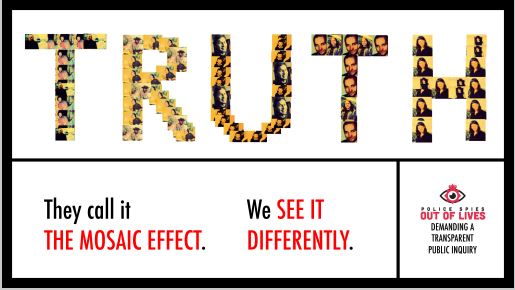
The ‘Mosaic Effect’ is the term used in a report by the Metropolitan Police Service (MPS) submitted to the Undercover Policing Inquiry. This report seeks to explain how the Mosaic Effect works and why it is perceived as a threat to the anonymity of former undercover police officers (UCO’s).
The premise of this report is that absolute secrecy must be maintained around these units and individual officers. They argue that even comparatively small leakages of information can be pieced together (like a mosaic) to enable identification of the officers by those whom they targeted, but also by journalists and researchers.
Following large demonstrations against the Vietnam War in 1968, the Home Office and MPS inaugurated a highly secretive undercover police unit called the Special Operations Squad (later the Special Demonstration Squad or ‘SDS’). These covert units were established to gather information about protest and struggles for justice within the UK.
The SOS/SDS operated in Greater London for fifty years and was joined by the National Public Order Intelligence Unit (NPOIU) in 1999, which was run by the Association of Chief Police Officers and operated in the UK regions. In 2014, prime minister Theresa May announced a judge led Inquiry into undercover policing to investigate the wrong doing exposed by activists and journalists.
The theory of the Mosaic Effect is that officers should not be identified as they would run the risk of becoming targets for violence by those they spied and reported upon. Further, those former UCO’s and their families may suffer psychological damage and interference in their private lives from being publicly associated with their deployments.
Superficially, this may seem a convincing argument. Some of the officers who were deployed in these units have said they were guaranteed anonymity from the outset. They claim that the dangerous nature of their undercover work means they must be afforded long term security, protection and anonymity.
The situation, however is more complex. The catalogue of abuses committed by these units is long, makes distressing reading and needs to be publicly understood. Without knowing – at the very least – these officers’ cover names, how can we understand the scale and significance of wrong doing implicit in infiltrations like these by the SDS and/or NPOIU:
- Infiltrated and reported upon the offices of elected politicians (all were Labour Party MP’s), sometimes reaching positions of authority and trust within these offices. Trade unions were similarly spied upon.
- Infiltrated family justice campaigns, often formed by families who had lost loved ones to police violence (Jean-Charles de Menezes), or racist attack where police had mishandled the investigation (Stephen Lawrence/Ricky Reel).
- Deceived women activists into long-term sexual relationships whilst in their cover identities. All of these officers had wives and often children at their real homes, whilst usually living with the women they targeted.
- Were responsible for miscarriages of justice, as they abused the lawyer/client privilege, acted as agent provocateur and used their false identities in court.
- Used the identities of deceased children as their cover identities. Some of the children’s families are core participants in the Public Inquiry.
- Supplied information to the illegal construction industry blacklist, thereby assisting in the loss of livelihood of dozens of trade union activists and safety reps.
The list of anti-democratic abuses is too long to mention here – but these units have, for five decades, spied on over 1000 groups primarily fighting for family, environmental and social justice.
This was not combatting terrorism or shutting down organised crime networks. It was tens of millions of pounds spent undermining democratically protected rights to protest.
These officers and their former employer, argue that to reveal their identities puts their safety, and the safety of their families and friends at risk. Despite activists working hard over the past decade to uncover the identities of several of these officers, there has yet to be a threat to any one of them.
Even the Met’s own report states ‘…although an objective assessment would suggest that this concern may be exaggerated, it does not lessen their perception of the risk’.
The police have fought with their vast resources to keep secret all of the information they hold. Officers have been responsible (but crucially not held to account) for destroying evidence that was destined for the Inquiry. We believe their aim is to keep the whole truth from public gaze. It is not, as they argue, to prevent risk of harm to the officers concerned.
They further argue that identification is an unacceptable intrusion into the private and family lives of the officers. Their hypocrisy is shocking. Officers and managers in these units showed no consideration for the private and family lives of the people they targeted and whose rights they abused. And now they refuse to provide the answers which might enable the healing process to begin. By withholding information from those targeted, they compound the initial abuse.
Some officers assert that they are suffering from trauma due to fear of public discovery of their identities. This is particularly difficult to hear, as not only did many of these officers used mental breakdown as an elaborate exit strategy from our lives but all those spied upon have experienced trauma and psychological harm as a result of these deployments. The Met’s concern for protecting the mental health of those affected by these units does not reach to members of the public. They have behaved, and continue to behave as if they are above the law.
The Mosaic Effect should not be considered a threat to the safety of individual officers. It should be welcomed by the Inquiry as a common goal of achieving the whole picture; of uncovering the truth. By piecing together and sharing fragments of information about our own lives and relationships, women like us have made sense of our experience. It’s how we’ve understood their tactics. It’s how we’ve exposed its systemic nature. And it’s how we cracked open some of the stories at the core of this long and expensive Inquiry.
They call it the Mosaic Effect. We call it discovering the truth.

